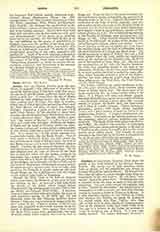

Jordanis or JORNANDES, historian, lived about the middle of the sixth century in the Eastern Roman Empire. His family was of high standing, either Goth or Alanic, and his grandfather was notary to Candac, King of the Alani in Moesia. He himself held for a time the office of notary, though under what circumstances is not well known. He was later “converted”, that is, he took orders. Everything else that is reported of his life rests on more or less plausible conjecture. It is not really proven, for example, that he bore “before his conversion” the martial name of Jornandes (i.e. bold as a boar), nor that after this conversion he became a monk in Thrace or in Moesia. It is also uncertain whether he was Bishop of Croton, and whether the Vigilius, to whom he dedicated his second work, was Pope Vigilius, who from 547 to 554 lived in exile, chiefly at Constantinople. Two of his historical works have come down to us. The one is a history of the Goths, or, perhaps it would be better to say, of Moesia. It is now commonly entitled: “De origine actibusque Getarum”, and is dedicated to his friend Castulus (Castalius), at whose instance it was begun about 551. It is substantially an extract from the Gothic history of Cassiodorus Senator, which probably bore the same title. But as this latter work was lost at a very early date, this excerpt becomes of almost inestimable value in determining a series of facts in the history of the Goths and of popular migrations. Naturally, Jordanis transplanted into his work the fundamental idea of Cassiodorus, namely the conviction that the only way to secure for the Gothic race a prosperous future was to bring about its peaceful absorption into the Roman Empire as the center of Catholicism and of civilization. The second of his works is sometimes called “De summa temporum vel origine actibusque gentis Romanorum”, sometimes “De regnorum et temporum successione”, at other times “Liber de origine mundi et actibus Romanorum ceterarumque gentium”, and again “De gestis Romanorum”. Jordanis served as a source of information for the geographers of Ravenna, for Paul the Deacon, for Hermann Contractus, Hugh of Flavigny, and others. The following, among some forty editions, are worth noting: Augsburg, 1515, of the recension of Conrad Peutinger; Migne, P.L., LXIX; Mommsen in “Monumenta Germ. Auctores antiquissimi”, V; Germ. tr. in the “Geschichtsschreiber der deutschen Vorzeit”, V; Fr. tr. by Savagner (Paris, 1842 and 1883); Swedish translation by Peringskiold (Stockholm, 1719).
PATRICIUS SCHLAGER

